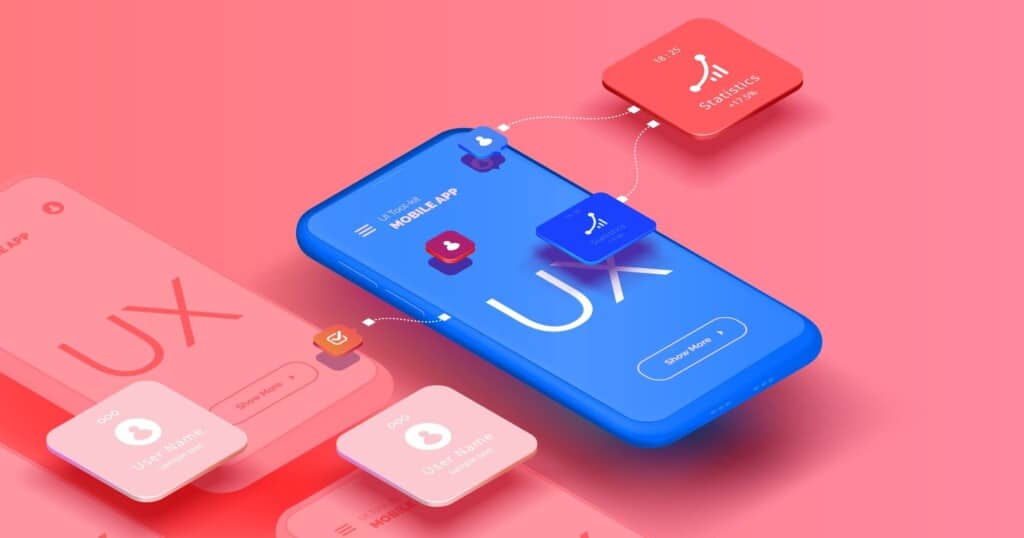Take a look around. Whether you’re at a coffee shop, on a train, or just sitting at home, chances are you’re surrounded by people glued to their phones. But it’s not just phones; it’s the apps. We swipe, scroll, tap, and double-tap through dozens of apps every day, from social media to banking to fitness tracking.
There’s a reason for this obsession. A 2023 report revealed that the average person spends 5 hours per day on mobile apps nearly one-third of our waking hours! But why? What makes an app so compelling that we can’t put our phones down? More importantly, what role does UX play in keeping us engaged or, better yet, addicted?
Let’s find out.
Why Are We So Indulged in Apps?
It’s not just about entertainment. Apps are designed to meet human needs, whether it’s the need for connection, achievement, convenience, or sheer distraction. And the best ones? They tap into our psychological triggers so seamlessly that we don’t even realize we’re hooked.
Think about it. When you get a notification, your brain gets a small dopamine hit. It’s the same chemical responsible for pleasure and addiction, whether that’s social validation from a new like on Instagram or a sense of accomplishment from completing a task in a productivity app. The mobile app developers who understand these psychological hooks are the ones creating the apps we can’t resist.
But what exactly makes an app addictive?
The Secret Ingredients of an Addictive App
We all have an app that accounts for most of our screen time. It can be an entertainment app like TikTok or a networking or professional development app like LinkedIn. But have you ever wondered what makes these apps so addictive? Let’s find out;
-
Instant Gratification
Humans hate waiting. In fact, a Google study found that 53% of mobile users flee a site if it is slow and takes more than three seconds to load. Apps that deliver instant feedback, whether it’s an immediate response to a tap, quick-loading content, or real-time interactions, keep users engaged.
A great app development company knows that every second counts. If an app lags, freezes, or requires too many steps to perform an action, users will drop off faster than you can say “uninstall.”
But it’s not just about speed. Instant gratification also means providing users with quick wins and small achievements that make them feel accomplished. Think about fitness apps that celebrate every completed workout with a congratulatory message or learning apps that award badges for progress. These micro-rewards tap into our psychological need for accomplishment, keeping us engaged.
-
The Infinite Scroll
Have you ever opened Instagram or TikTok for “just five minutes,” and suddenly an hour has passed? That’s no accident. Infinite scrolling keeps users trapped in an endless loop of content with no stopping point in sight. Custom app developers strategically remove natural stopping cues, making it very easy to lose track of time.
But why does this work so well? The answer lies in our mind’s reward system. Every time we scroll, we anticipate something new and exciting. It can be a funny video, an insightful post, or a shocking headline. This anticipation triggers dopamine release, the same chemical associated with pleasure and addiction.
Apps that incorporate infinite scrolling also use subtle UI tricks to keep users engaged. Smooth transitions, seamless content loading, and algorithm-driven personalization make every swipe feel effortless. By making sure that the next piece of content is always within reach, apps create a frictionless experience that makes users forget about time.
-
Social Validation
We crave social approval; it’s wired into our DNA. That’s why apps that use likes, shares, and comments to create engagement loops are so powerful. Seeing a notification pop up triggers a psychological reward, making users come back repeatedly.
But there’s a deeper layer to social validation. The Fear of Missing Out plays a critical role in app addiction. Social media platforms thrive on this by showing users what their friends are doing, what’s trending, and what’s happening in real-time. Push notifications like “Your friend just posted a new story!” create an urgency to check the app immediately.
Even non-social apps use this principle. Gaming apps show leaderboards, fitness apps let users compare stats, and shopping apps highlight trending products. By making users feel like they’re part of a larger community, apps keep them engaged and coming back.
-
Variable Rewards
Imagine you’re pulling the lever on a slot machine. Sometimes, you win, and sometimes, you don’t, but the uncertainty keeps you playing. Apps use the same principle. Whether you’re refreshing your feed to see new posts or opening a mystery reward in a game, the unpredictability keeps you coming back for more.
The psychology behind variable rewards is powerful. When users don’t know exactly what they’ll get, they’re more likely to keep engaging. Email apps use this by showing a red notification badge, prompting users to check their inboxes. Sometimes, it’s an important message, sometimes it’s spam, but the possibility of a reward keeps them clicking.
Even e-commerce apps use variable rewards. Flash sales, surprise discounts, and daily deals create an addictive loop where users check back frequently just in case they find something amazing. This strategy is why so many people compulsively check shopping apps even when they don’t need anything.
-
Habit Formation
Habit-forming apps master the cue-routine-reward cycle. A notification (cue) reminds you to check the app (routine), and when you do, you receive a reward, whether it’s a message, a discount, or new content. Over time, this cycle becomes automatic, making the app a natural part of your daily life.
Many mobile app developers build habits by integrating seamlessly into users’ daily routines. Take meditation apps, for example; they send gentle reminders at specific times of the day, reinforcing mindfulness habits. Similarly, ride-sharing apps predict when you’ll need a ride based on past behavior and send timely suggestions.
Breaking free from these habits can be tough because the brain starts associating certain triggers with app usage. If an app becomes part of a user’s morning routine, skipping it might feel unnatural. This is why some people instinctively open social media the moment they wake up; it has become a deeply ingrained habit.
-
Personalization
The more an app understands you, the harder it is to leave. From personalized content recommendations to custom notifications, apps that cater to individual preferences make users feel like the app was designed just for them. This emotional connection boosts engagement and retention.
Custom app developers use advanced AI and machine learning to analyze user behavior and tailor experiences accordingly. Netflix, for instance, curates content based on watch history, while e-commerce apps suggest products based on past purchases. The result? Users feel like the app “gets” them, making them more likely to stay engaged.
However, personalization goes beyond recommendations. Apps that allow users to customize settings, change themes, or set preferences create a sense of ownership. When users feel like they have control over their experience, they’re more likely to stick around.
Why UX is the Backbone of an Addictive App
Now that we know what makes an app addictive, let’s talk about something just as important: User Experience (UX). You can have all the psychological tricks in the book, but if the app is frustrating to use, people won’t stick around.
Here’s why UX is everything.
-
First Impressions Matter
Users decide within seconds whether they’ll continue using an app. If an app’s interface is cluttered, confusing, or just plain ugly, they’re out. An intuitive, clean, and visually appealing design is non-negotiable.
-
Simplicity Wins Every Time
Have you ever downloaded an app, opened it, and immediately felt lost? That’s bad UX. The best apps are simple. They don’t overwhelm users with too many choices or unnecessary features. Every tap should feel natural, and every screen should have a clear purpose.
-
Navigation Should Feel Like Second Nature
If users have to “figure out” how to use your app, something is wrong. Navigation should be intuitive. Buttons should be in places where users expect them. Features should be easy to find. Every detail should feel effortless.
-
Speed and Performance Keeps Users Hooked
A slow app is a dead app. If an app lags, crashes, or drains too much battery, users won’t tolerate it. Custom app developers understand the importance of performance optimization, keeping apps light, fast, and efficient.
-
Micro-Interactions Make a Big Difference
Micro-interactions, those tiny animations and responses that happen when you tap a button or scroll, make the experience feel more human. Whether it’s a satisfying “click” sound, a smooth transition, or a playful animation, these details improve user engagement.
-
Accessibility Matters More Than You Think
A great UX isn’t just about aesthetics; it’s about inclusivity. Apps should be easy to use for everyone, including those with disabilities. Features like voice commands, high-contrast modes, and screen reader compatibility make an app more accessible and widely adopted.
-
Continuous Improvements Keep Users Coming Back
UX isn’t a one-and-done deal. The best app development companies constantly analyze user behavior, conduct A/B testing, and refine their designs based on real feedback. Regular updates help keep the experience fresh and engaging.
Final Thoughts
Apps are more than just tools; they’re experiences. And the most addictive apps? They don’t just function well; they feel good to use. From psychological hooks to seamless UX, everything is designed to keep users engaged for as long as possible.
If you’re looking to work with a mobile app developer or an app development company, understanding what makes an app addictive and why UX is critical can make the difference between an app that people download and forget and one they can’t stop using.
So, the next time you catch yourself glued to an app, ask yourself: is it the content, the design, or something deeper? Chances are, it’ll be all of the above.






